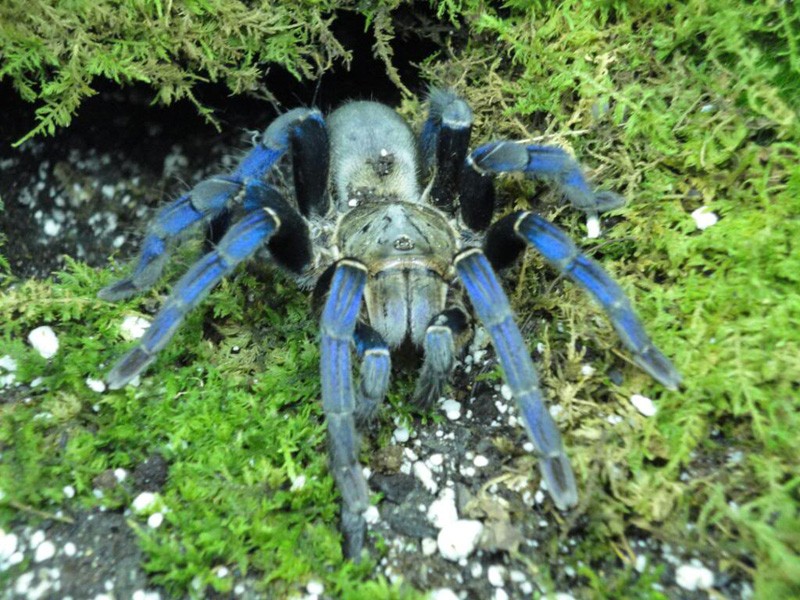

Today we will discuss the 10 most amazing facts about the Blue Cobalt tarantula to explain why this species appeals to so many spider lovers: 1. This arachnid is one of the most impressive specimens of its species, thanks to its amazing metallic-blue coloring and unique behavior. “Fieldwork conducted by us during the last few years,” Benjamin says, “has shown the presence of an abundant, largely unexplored spider fauna living in the remaining forest patches of the island.If you think tarantulas are fascinating creatures, wait to see the Blue Cobalt tarantula. Given that, get ready for more newly described spiders to crawl into the news. The only guide to Sri Lankan spiders was published more than a century ago, he adds. Though the country is a treasure trove of biodiversity, only a fraction of its riches have been closely studied since independence in 1948, Benjamin says.įor instance, of the 593 spider species currently identified on the island, 108 were described within the last two decades. ( Read about a new species of high-altitude tarantula.) That such large spiders could hide in plain sight, even now, is not particularly astonishing in Sri Lanka, says Suresh Benjamin of Sri Lanka’s National Institute of Fundamental Studies, who was not involved in the new research. Ornately decorated with interlocking geometric patterns, and with a legspan that could comfortably reach around your face, this so-called tiger spider ended up being a media sensation.ĭuring a night survey in the Peruvian forest, scientists saw a spider catch this remarkable meal. In 2013, he described a new species of massive, tree-dwelling tarantula called Poecilotheria rajaei. This is not the first time Nanayakkara has identified a scene-stealing Sri Lankan tarantula. jonitriantisvansicklei is particularly rare or threatened, but other Sri Lankan spiders are listed as endangered. Raven notes that in areas like Sri Lanka, high levels of biodiversity are often coupled with small populations-“and even smaller scientist numbers.”Īt the moment, scientists don’t know whether C. Genetic sequencing can confirm that the spiders are unique the analysis is also crucial for understanding the spiders’ evolution and for planning conservation strategies. andersoni, are widespread, the possibility that the new one is one of the named Indian species will eventually need to be addressed.” ( See more photographs of colorful tarantulas.) “I accept the species as a good new species,” says Robert Raven, principal curator of arachnids at Australia’s Queensland Museum.

jonitriantisvansicklei’s position on the family tree.Ī burgundy goliath bird eater ( Theraphosa stirmi) photographed at Virginia Zoo in Norfolk Photograph by Joel Sartore, National Geographic Photo Ark Though the spiders are clearly new to Sri Lanka, experts say more genetic research is needed to clarify C. The discovery highlights the rich diversity of Sri Lankan wildlife, and how many spider species are yet to be found. He eventually concluded that the spider was unique, as he and colleagues reported in the British Tarantula Society Journal, and named the species after donor Joni Triantis Van Sickle. Nanayakkara, a prolific spider-hunter from Sri Lanka’s University of Kelaniya, collected some of the shimmery arachnids on an expedition in 2015, then spent two years making detailed physical comparisons between them and known Chilobrachys species. Neighboring India is home to more than two dozen closely related Chilobrachys species, and while many are mostly unremarkably brown, several are similarly adorned. jonitriantisvansicklei is only the second species within the Chilobrachys genus to be found in Sri Lanka the first, a drab brown arachnid called C. “The males,” he notes, “are smaller and are mossy brown in color.”Ĭ. “When we first spotted them I was in awe, lost for words,” Nanayakkara says of the decked-out females. ( Read why science still can’t explain some blue tarantulas.) In fact, it’s these snazzy blue colors that first caught biologist Ranil Nanayakkara’s attention, and flagged the critters-now named Chilobrachys jonitriantisvansicklei-as potentially new to science. Measuring roughly five inches from tip to tip, these spiders are not exactly small, nor are their brilliant blue patches particularly subtle. Living in tubular, silk-lined burrows, they are fast and aggressive, seizing unlucky insects that wander too close to their underground lairs.
#Blue cobalt tarantula Patch
Scientists found the arachnids within an isolated patch of southwestern rainforest, ringed by tea and rubber plantations. Sri Lanka is home to a new species of tarantula-and its females are fuzzy, turquoise-tinged, and big enough to comfortably hug a donut.


 0 kommentar(er)
0 kommentar(er)
